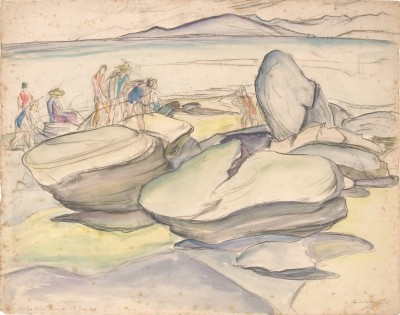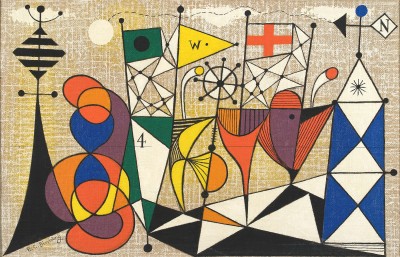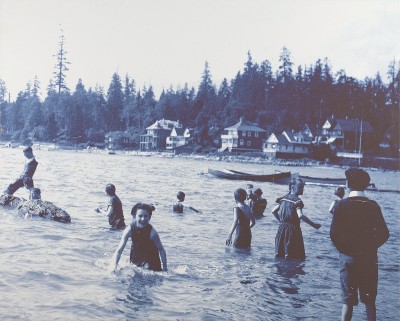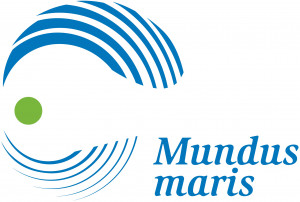Melancholy Bay: Images of English Bay, Burrard Inlet and Howe Sound from the Collection
June 19 to August 23, 2015
Opening reception: Thursday, June 18, 6-8 pm
Curator’s Tour with Scott Watson: Saturday, June 20, 1-2 pm
This exhibition from the permanent collection began as a response to the recent oil spill in English Bay. The University of British Columbia, located on unceded Musqueam territory and only kilometres west of the ancient city of c̓əsnaʔəm, looks out over English Bay, Howe Sound and the Georgia Straight, all bodies of water renamed by Captain George Vancouver in the 1790s. The title Melancholy Bay is a reference to his dispirited response to what he saw as “a sublime, though gloomy spectacle.” The settler culture that followed Captain Vancouver to establish jurisdiction and displace the indigenous villages and place names has been consistent in admixing descriptions of majestic landscape with ideas of frontier and resource extraction. As a result we tend to naturalize the large visual imprint made by resource extraction industries as picturesque.

That is, until there is an oil spill. Log booms clog the mouth of the Fraser River, freighters wanting to load and unload clog English Bay. In the future, more of them potentially will be loading oil piped in from an expanded Kinder-Morgan pipeline and the risk of future spills will increase as response readiness decreases. Media reports during the immediate aftermath suggested response time to a spill in Bellingham Bay was planned to be an hour. In English Bay it was twelve hours.
The University’s Art Collection yields works that can be seen as historic documents as well as art. Irene Hoffar Reid painted and drew the bay in the 1930s as the sublime, even mystical (she was a student of Frederick Varley and Jock Macdonald’s short-lived British Columbia College of Arts) setting for leisure and depiction of heroic smelt fishermen. Jack Shadbolt’s drawings from the 1940s of shacks west of the Burrard Street Bridge on the south shore depict an area of Vancouver’s waterfront that has now been returned to the Squamish people.
B.C. Binning’s romance with boats, docks and the sun-dappled waters of English Bay and Howe Sound from the 1940s expressed “classical calm” that was a rebuke to a world at war. Gordon Smith’s Dundarave (1972) explores the same seascape through an orderly, abstract shifting grid.

The intertidal zones were the sites for important conceptual works in the early 1970s. The University Art Collection and the Belkin Art Gallery Archives contain documents of such works. Michael Morris and Image Bank sited Dot Depth of Field (ca. 1970), a perspectival essay, on Spanish Banks. Al Neil has had a cabin on Burrard Inlet since 1966 that he has used as a retreat and a studio. During that time he collected newspaper articles about the Inlet, these are now a sculpture. Neil’s partner Carole Itter has worked in the studio since the early 1980s. She has been a careful observer of Burrard Inlet since childhood and the Inlet is the subject of several recent works. We are showing sketches and plans for her monumental installation Inlet, as well as a film InLet (2009). Tom Burrow’s Mudflat Sculptures (1970-71) were featured in the Belkin’s last exhibition.
Roy Arden’s study for his ghostly public mural People of British Columbia (2008) uses archival photos of swimmers at English Bay. Like Binning, Arden represents the bay as an idyllic place for leisure and opening one’s senses to nature. But the central figure (seen three times) is a child covering his face with his hands, a gesture of inwardness in counterpoint to the sweep of early twentieth century mass leisure. Stephen Waddell’s Wader (2006) gives another account of swimming in the bay. Is the figure exuberant or intoxicated? His abandon is ambiguous.

Mark Lewis’s From Third Beach 1 (2010) is a black and white film projection of two freighters. The short film is almost without event except for the lapping of the sea on the shore. Shot from a very low angle under a grey lowering sky, the scene is ominous. Mark Soo’s Monochrome Sunset (English Bay-Oppenheimer Park) (2006) decolourizes a transparency of an English Bay sunset through the use of yellow-orange sodium lights – the lights used in Oppenheimer Park to discourage drug use by making it hard to see one’s veins under the skin. Marian Penner Bancroft’s book work, Two Places at Once (1983) (and studies for the same), depicts the shores of English Bay and Kitsilano from the water. Her work, which deals with a personal memory, is especially prescient, warning of the dangers of polluting the bay. Anne Ramsden’s Urban Geography (1990) is installed in this exhibition as a seven-monitor piece with text panels. Its episodes depict two women scouting for a film location in Greater Vancouver. Included are segments that research the sulphur piles on Burrard Inlet’s north shore, a docked ship, the view of English Bay from the grounds of the UBC Museum of Anthropology and a scene on Spanish Banks. Finally, Christos Dikeakos’s Sites and Place Names: Vancouver (1991-94) is a project that researched and restored Salish place names in what is now Greater Vancouver.
The conversations among these works do not exhaust the possible, but they point toward histories that still require redress and the continuing folly of extracting non-renewable resources with no alternate plan for the future.
This exhibition is made possible with the generous support of the Canada Council for the Arts. We gratefully acknowledge the Canada Council Acquisitions Assistance program, the Morris and Helen Belkin Foundation, our Belkin Curator’s Forum members and our individual donors who financially support our acquisitions and donate artworks to the collection.
For more information, please contact:
Jana Tyner
UBC Morris and Helen Belkin Art Gallery
1825 Main Mall
Vancouver, BC V6T 1Z2, Canada
t. 604.822.1389
www.belkin.ubc.ca
